[1] Yamaguchi M, Kitamura A, Oda Y et al. Predicting the long-term 137Cs distribution in Fukushima after the Fukushima Dai-ichi nuclear power plant accident: a parameter sensitivity analysis[J]. Journal of Environmental Radioactivity, 135, 135-146(2014).
[2] NING Shasha, SHAN Zheng, LIU Aihua et al. LOCA I-131 source term analysis for the proposed Taohuajiang AP1000 NPP[J]. Nuclear Techniques, 35, 69-73(2012).
[3] YAN Zheng, WU Xinmin, DENG Lei et al. An M-C model to simulate airborne radioactive material dispersion in nuclear accident[J]. Nuclear Techniques, 34, 193-198(2011).
[4] Leelőssy Á, Mészáros R, Lagzi I. Short and long term dispersion patterns of radionuclides in the atmosphere around the Fukushima Nuclear Power Plant[J]. Journal of Environmental Radioactivity, 102, 1117-1121(2011).
[5] Sawan M E, Abdou M A. Physics and technology conditions for attaining tritium self-sufficiency for the DT fuel cycle[J]. Fusion Engineering and Design, 81, 1131-1144(2006).
[6] Taylor N. Preliminary safety report (RPrS)[R](2011).
[7] OGAWA Y. Assessment on safety and security (reassurance) for fusion plant[C], 1-27(2013).
[8] Raskob W. Doses from accidental releases of tritium and activation products into the atmosphere[J]. Journal of Fusion Energy, 12, 149-156(1993).
[9] Raskob W, Hasemann I. Results of dose calculations for NET accidental and normal operation releases of tritium and activation products[M]. Kernforschungszentrum Karlsruhe(1992).
[10] Taylor N P, Raskob W. Updated accident consequence analyses for ITER at cadarache[J]. Fusion Science and Technology, 52, 359-366(2007).
[11] Cortes P, Iseli M, Taylor N. Sensitivity studies on the accidental impact of 1 G of tritium for ITER site specific characteristics[J]. Fusion Science and Technology, 60, 865-868(2011).
[12] Nie B J, Ni M Y, Jiang J Q et al. A dynamic modeling 3H transfer to the environment under accidental release from the fusion reactor[J]. Journal of Fusion Energy, 34, 739-745(2015).
[13] NIE Baojie, NI Muyi, LIAN Chao et al. Development and verification of tritium atmospheric dispersion program based on turbulent diffusion theory[J]. Atomic Energy Science and Technology, 47, 541-546(2013).
[14] TONG Zhiquan[M]. Atmospheric environmental impact assessment(1991).
[16] GU Qing, LI Yunsheng[M]. Calculation method of atmospheric environment model(2002).
[17] SONG Miaofa, QIANG Yizhong[M]. Fundamentals of nuclear environmentology(1999).
[18] LUO Zhengming. The reflection of H+, D+ and T+ from surface of solids[J]. Acta Physica Sinica, 39, 1520-1530(1990).
[19] Brown R M, Ogram G L, Spencer F S. Field studies of HT behaviour in the environment: 1. dispersion and oxidation in the atmosphere[J]. Fusion Technology, 14, 1165-1169(1988).




